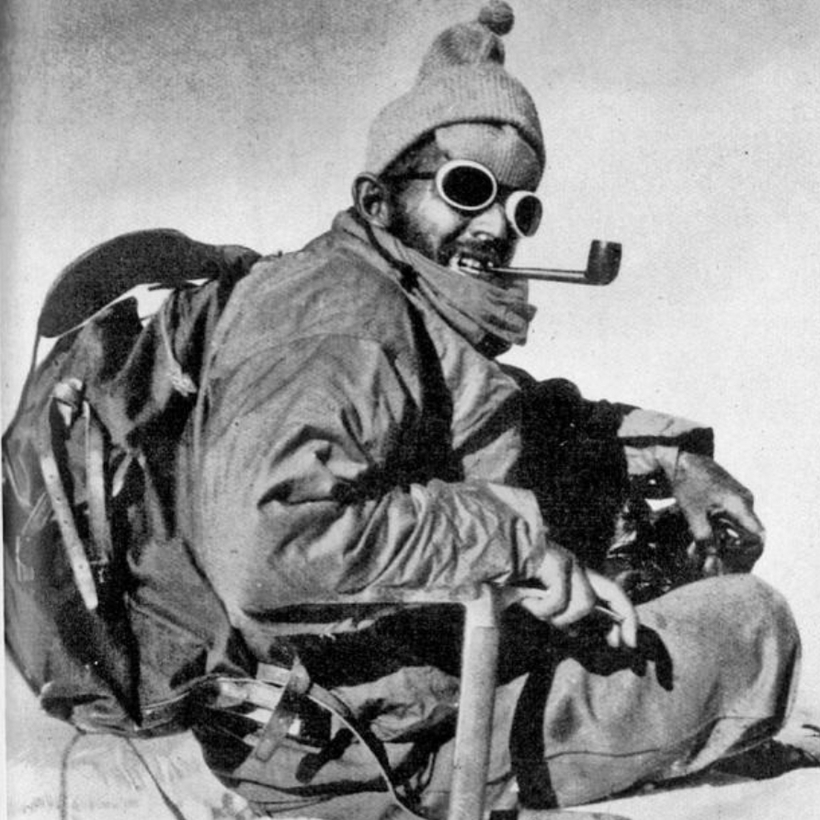Historians of the golden era of Himalayan mountaineering credit its triumphs to the use of bottled oxygen to overcome the thin air of the “death zone” above 25,000ft.
Perhaps they should have paid more attention to the expedition records, which reveal a little-known fact: many of our greatest climbers were not so much gasping for air as gagging for a cigarette. Packed in with mountaineering equipment such as ice axes and ropes, the records show, were truly heroic supplies for the smokers.
Burn After Climbing
When Edmund Hillary and Tenzing Norgay made the first ascent of Everest in 1953, the team took 15,000 cigarettes with them: 5,000 from Imperial Tobacco, makers of Capstan, and 10,000 from Carreras, producers of Craven A. While neither man is thought to have smoked, John Hunt, the leader of the expedition, was a pipe smoker, as was Charles Evans, one of the first two men to reach Everest’s South Summit. Wilfrid Noyce, one of the first two men to reach the South Col, smoked cigarettes.
The 1955 expedition that conquered the world’s third highest peak, Kangchenjunga, took with it 25,000 cigarettes and 16lb of tobacco, according to Mick Conefrey, the author of The Last Great Mountain, published in advance of the 65th anniversary of the ascent earlier this week. While many of the cigarettes were for the porters and Sherpas, about 5,000 were western brands intended for the two smokers in the climbing team that tackled the 28,169ft Himalayan peak.
Many of our greatest climbers were not so much gasping for air as gagging for a cigarette.
One of the smokers was Joe Brown, a British climber who is thought to have puffed his way through as many as 2,000 cigarettes during the trip — and smuggled 1,000 back to Britain.
Brown, who died last month at the age of 89, told Conefrey he smoked five cigarettes in the bivouac tent he shared with his climbing partner, George Band, a non-smoker, on the eve of their summit climb. It was at 26,900ft, where the concentration of oxygen in the air is 7.5%, compared with 20.9% at sea level, and he used bottled oxygen to sleep that night. Brown said at the time he wished he had brought a whole packet, but came to regret his behaviour. “I’ve thought since, ‘What a horrible thing to do, to inflict it on George’, because he was in the tent too, and I’ve thought, ‘What a bastard’,” he said.
Despite Brown’s enthusiasm for nicotine, even at high altitudes with perilously little oxygen, Conefrey notes that he went on to outperform Band in the successful push to the summit.
A Cigarette a Day …
Brown made no health claims for his smoking habit. However, George Finch, the scientist who in 1922 first persuaded the committee organising attempts on Everest that bottled oxygen was vital to their success, believed smoking at high altitude could improve a mountaineer’s performance.
Finch, a chemist based at Imperial College London, was a member of the 1922 expedition that saw George Mallory make the first serious attempt on the world’s highest peak. Before departure, Finch subjected himself to an experiment in a decompression chamber where the pressure was lowered to simulate conditions at 23,000ft. Once on the mountain, he developed a theory about the power of cigarettes that went beyond their “invigorating” and “stimulating” effect.
The scientist George Finch believed smoking at high altitude could improve a mountaineer’s performance.
While sheltering in a storm-bound tent at 25,500ft, Finch observed that he and his two companions risked asphyxiation unless they made a conscious effort to breathe — yet the effort was so great that sleeping was “absolutely out of the question”. Once they smoked, however, their breathing reverted to the “automatic” kind and “the effect of a single cigarette lasted for up to three hours”. When they emerged after two nights, they reached an altitude of 27,300ft, a new world record.
Mallory was a pipe smoker, as was Sandy Irvine, with whom he made his final, fatal attempt on the summit in 1924. Irvine’s own habits, and priorities, can be seen in an aide memoire he scribbled after a trip to Spitsbergen in northern Norway the previous year. Under the heading “Notes for Future”, he wrote “pipe cleaners” ahead of “climbing boots” and “socks that don’t shrink”.
Martin Boysen, 78, a member of the team, led by Sir Chris Bonington, that first climbed the southwest face of Everest in 1975, recalls how he used to savour lighting up at the summit of some of his most memorable climbs — and enjoyed a puff at 27,300ft on the night before his attempt on Everest’s peak. “It was one of the great pleasures of climbing,” he said. “It was like Proust’s madeleine moment” — a reference to the cakes that triggered memories of childhood for the French writer of In Search of Lost Time.
Yet Boysen’s abiding memory is of the day Bonington’s expedition conquered Everest. His oxygen having failed, he was forced to retreat down the mountain, while, up above, one of his friends had gone missing. And he had run out of cigarettes to console himself.

